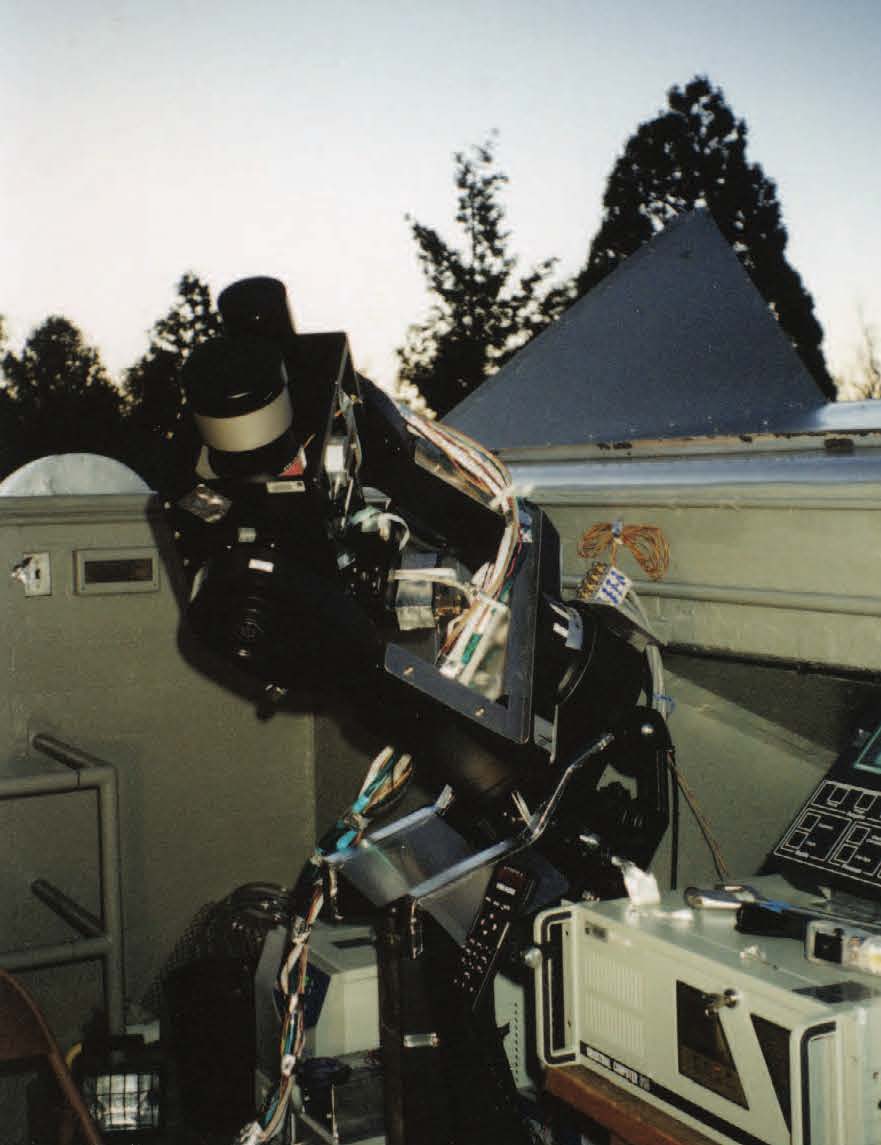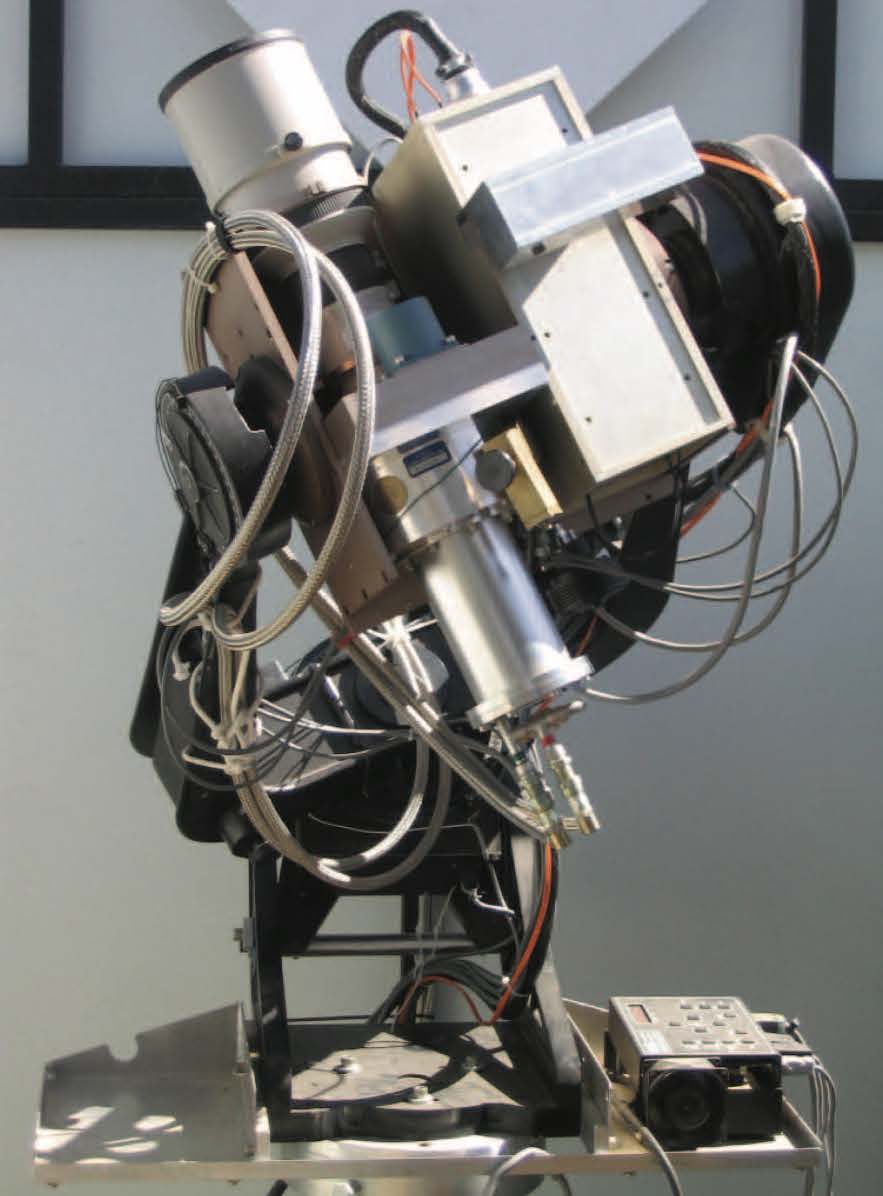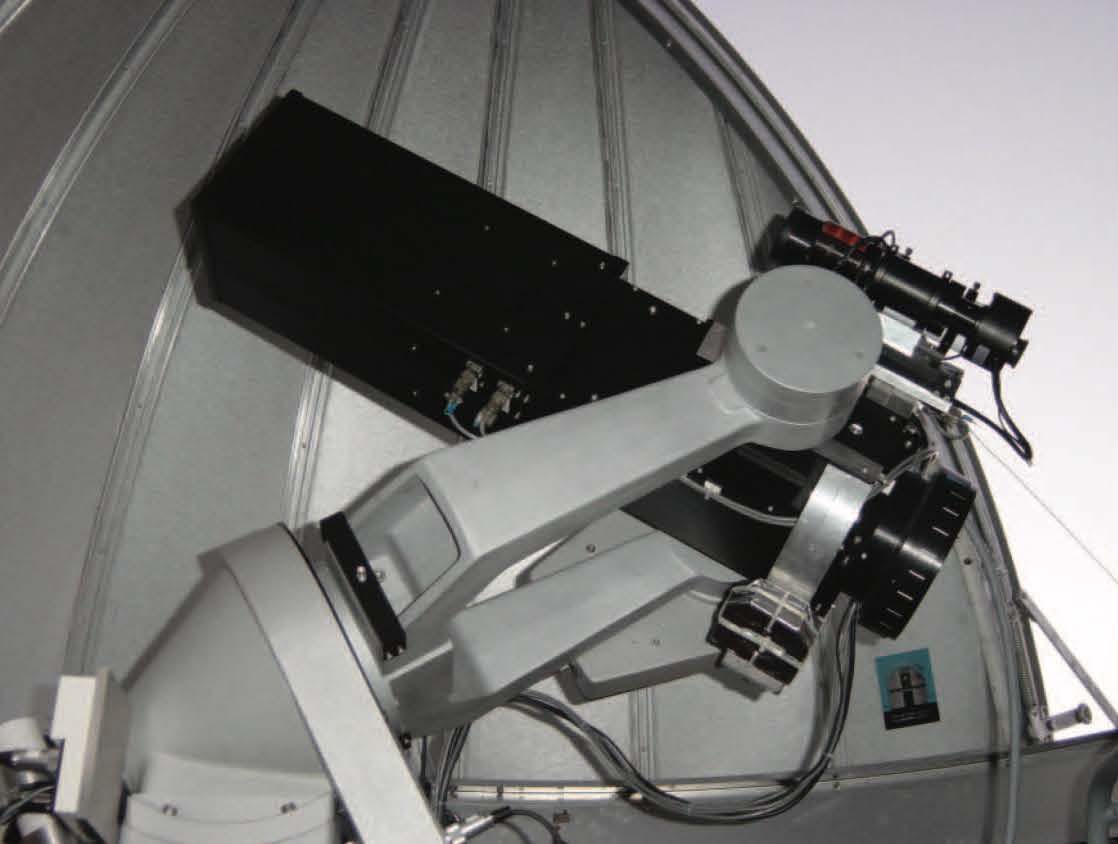TrES: The Transatlantic Exoplanet Survey
Introduction
 |
 |
 |
TrES (original web page), the Transatlantic Exoplanet Survey, was a network of three small-aperture telescopes (pictured above) searching the sky for transiting planets. The network consisted of Sleuth (Palomar Observatory, Southern California), the PSST (Lowell Observatory, Northern Arizona) and STARE (Observatorio del Teide, Canary Islands, Spain).
Our method of detection relied on the edge-on alignment of the extrasolar system. If a planetary system is oriented so that Earth lies near the plane of the planet’s orbit, then once per orbit the planet passes between its star and the Earth, causing a transit. This orientation is more likely for planets orbiting close to their parent star. During a transit, the planet blocks some of the light from the star, causing the star to appear dimmer. For Jupiter-sized planets transiting Sun-sized stars, the expected dimming of the star’s light will be about 1%, and the duration of the transit should be a few hours.
To look for such a transit, the TrES telescopes took timed exposures of the same field-of-view all night for as many nights as the field is favorably positioned (usually around 2 months). When an observing campaign was completed for a particular field, the multitude of data was run through software which, after correcting for many sources of distortion and noise, produced light curves for thousands of stars in the field. Other software was run to analyze the processed data for variable stars and transit candidates. It took two or more transits (or cycles in a variable star) to discern the period of the orbit (or the variability).
The TrES method favored giant planets orbiting sun-like stars in close orbits. The results of successful radial-velocity planetary searches showed that planetary systems of this type could be quite common.
See the STARE web page for a summary of The Search for Exoplanets.
Sleuth: The Palomar Planet Finder
More details on Sleuth, the telescope I used for my PhD discovery of three exoplanets, can be found on the Sleuth main page.
Additional telescopic support at Palomar Observatory was provided by:
A nice summary of the Palomar trio of telescopes was written up by the San Diego Union Tribune.
In the News
-
Stephen Colbert adopts TrES-2!
-
Number 5 is in the bag…, TrES-5!
-
We found the largest known transiting planet at the time, TrES-4.
-
We found a transiting planet, TrES-3, with 1.9 Jupiter masses and an orbital period of only 1.3 days.
-
TrES-2, the first known transiting planet in the Kepler field and the most massive nearby transiting planet at the time, discovered using small-aperture telescopes.
-
First direction detection of light from extrasolar planets. TrES group identified thermal emission from the hot Jupiter TrES-1.
-
TrES group announced the discovery of a new detached M-Dwarf Eclipsing Binary!
-
Discussion of identifying insidious blend contaminants common in wide–field transit surveys, such as TrES.
-
TrES Network Success: Transiting Planet Discovered. Transits of TrES-1 observed using 10-cm telescope.
TrES Publications
-
TrES-5: A Massive Jupiter-sized Planet Transiting a Cool G Dwarf The Astrophysical Journal, Volume 741, p. 5, November, 2011.
-
The Broadband Infrared Emission Spectrum of the Exoplanet TrES-3, The Astrophysical Journal, Volume 711, p. 374, March, 2010.
-
Detection of Planetary Emission from the Exoplanet Tres-2 Using Spitzer/IRAC, The Astrophysical Journal, Volume 710, p. 1551, February, 2010.
-
A New Spectroscopic and Photometric Analysis of the Transiting Planet Systems TrES-3 and TrES-4, The Astrophysical Journal, Volume 691, p. 1145, February, 2009.
-
Detection of A Temperature Inversion in the Broadband Infrared Emission Spectrum of TrES-4, The Astrophysical Journal, Volume 691, p. 866, January, 2009.
-
T-Lyr1-17236: A Long-Period Low-Mass Eclipsing Binary, The Astrophysical Journal, Volume 687, p. 1253, November, 2008.
-
The Prograde Orbit of Exoplanet TrES-2b, The Astrophysical Journal, Volume 682, p. 1283, August, 2008.
-
Identification, Classifications, and Absolute Properties of 773 Eclipsing Binaries Found in the Trans-Atlantic Exoplanet Survey, The Astrophysical Journal, Volume 135, p. 850, March, 2008.
-
Extrasolar planet detection by binary stellar eclipse timing: evidence for a third body around CM Draconis, Astronomy and Astrophysics, Volume 480, p. 563, March, 2008.
-
The detection and exploration of planets from the Trans-atlantic Exoplanet Survey, Ph.D. Thesis, California Institute of Technology, 2008.
-
TrES-3: A Nearby, Massive, Transiting Hot Jupiter in a 31-Hour Orbit, The Astrophysical Journal, Volume 663, p. L37, September, 2007.
-
TrES Exoplanets and False Positives: Finding the Needle in the Haystack, ASP Conference Series: “Transiting Extrasolar Planets Workshop”, September, 2007.
-
Improving Stellar and Planetary Parameters of Transiting Planet Systems: The Case of TrES-2, The Astrophysical Journal, Volume 664, p. 1190, August, 2007.
-
The Transit Light Curve Project. VI. Three Transits of the Exoplanet TrES-2, The Astrophysical Journal, Volume 664, p. 1185, August, 2007.
-
The Transit Light Curve Project. I. Four Consecutive Transits of the Exoplanet XO-1b, The Astrophysical Journal, Volume 652, p. 1715, December, 2006.
-
Outcome of Six Candidate Transiting Planets from a TrES Field in Andromeda, The Astrophysical Journal, Volume 662, p. 658, October, 2006.
-
Rejecting Astrophysical False Positives from the TrES Transiting Planet Survey: The Example of GSC 03885-00829, The Astrophysical Journal, Volume 644, p. 1237, June, 2006.
-
Detection of Thermal Emission from an Extrasolar Planet The Astrophysical Journal, Volume 626, p. 523, June, 2005.
-
A New Detached M Dwarf Eclipsing Binary The Astrophysical Journal, Volume 625, p. L127, June, 2005.
-
The Challenge of Wide-Field Transit Surveys: The Case of GSC 01944-02289 The Astrophysical Journal, Volume 621, p. 1061, March, 2005.
-
Searching for Transiting Planets and Eliminating False Positives in a TrES Field in Cygnus presented at the 2005 Aspen Center for Physics Winter Conference on Astrophysics.
-
_Further Sleuthing: Candidates from a New Field in Andromeda presented at the 2004 XVI Canary Islands Winter School of Astrophysics.
-
High-Resolution Spectroscopy of the Transiting Planet Host Star TrES-1 The Astrophysical Journal, Volume 616, p. L167, December, 2004.
-
PSST: The Planet Search Survey Telescope The Publications of the Astronomical Society of the Pacific, Volume 116, p. 1072, November, 2004.
-
TrES-1: The Transiting Planet of a Bright K0 V Star The Astrophysical Journal, Volume 613, p. L153, October, 2004.
-
STARE operations experience and its data quality control Astronomische Nachrichten, Volume 325, p. 594, October, 2004.
-
First Results From Sleuth: The Palomar Planet Finder The Search for Other Worlds, AIP Conference Proceedings, Volume 713, p. 169, June, 2004 (PDF).
-
Sherlock: An Automated Follow-Up Telescope for Wide-Field Transit Searches The Search for Other Worlds, AIP Conference Proceedings, Volume 713, p. 173, June, 2004.
-
Astrophysical False Positives Encountered in Wide-Field Transit Searches The Search for Other Worlds, AIP Conference Proceedings, Volume 713, p. 151, June, 2004.

Leave a comment